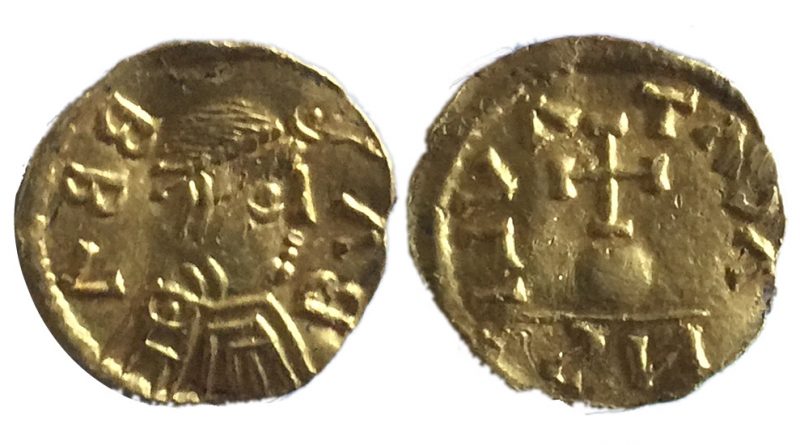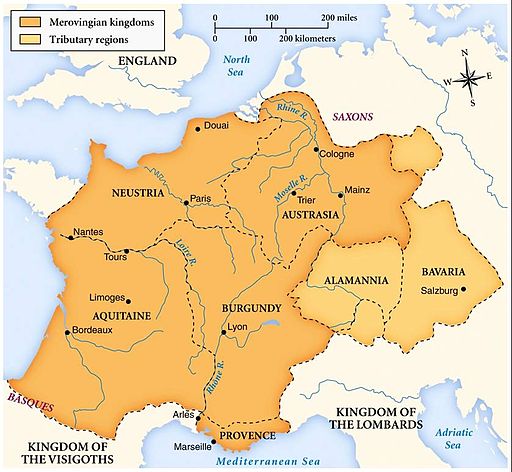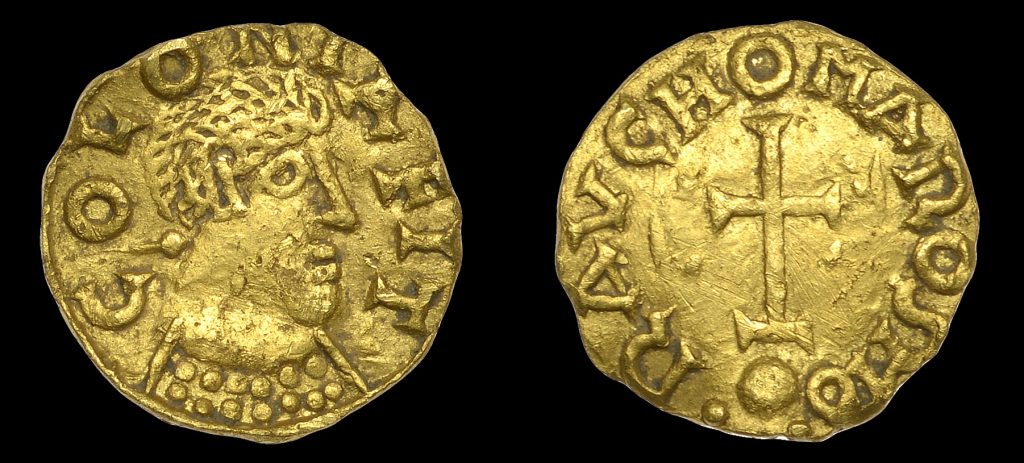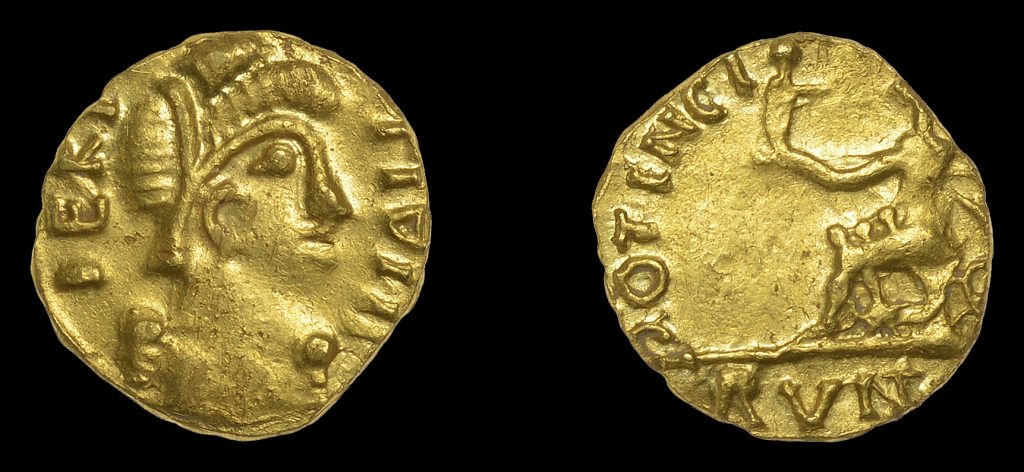Merovingian Tremissis
Glenn Evans unearthed this gold coin during 2018. It measures 13,67mm in diameter, weighs 1.34 grams and the gold content is 94%. On the obverse is a bust facing right and the short legend reads BABBA or BVBBA (the moneyer’s name). The reverse has a cross resting on a globe and the legend (retrograde and starting about 6 o’clock) has been read as SILVATACAN. This coin is a Merovingian tremissis, of which a huge number of types and varieties are known.
The Merovingians
Migration Period
Who were the Merovingians? To answer this question it is necessary first to look at what became known as the Migration Period. The date range is sometimes given as wide as the 3rd to the 11th century but in Europe the high point was the 3rd to the 6th century. This was a time when peoples moved from one place to another; the reasons included a thirst for plunder, jealousy of the power of Rome or simply a better place to settle.
The Franks
The Franks were a confederation of tribes, who in the late 2nd and early 3rd centuries, replaced earlier Germanic groupings in the west. As their influence grew they proved to be a thorn in the side of more than one Roman emperor. However, they were eventually defeated by Constantine and Crispus after a protracted campaign ended in 320 AD.
In 406 AD the Franks was one of the tribes that crossed the frozen Rhine and went on to devastate Gaul. They stayed in Gaul but they had rivals: Germans, Burgundians, Visigoths and Alamanni. Additionally, the Romans fought on, not wanting to give up a precious province. Aetius, the general under Valentinian III, narrowly failed to drive the Franks from northern Gaul but did crush the Huns in AD 451. However, the murder of Aetius in AD 454 meant that Gaul would fall to the strongest of the barbarian federations.
The Salian Franks
The Salian Franks, so-called because they claimed descent from the sea, were known as Merovingians. They established their control over most of Gaul during the reign of Clovis. He became king in AD 481 and is regarded as the founder of the French monarchy. His position was made secure through the elimination of lesser Frankish kings and military victories over the Visigoths and Alamanni.
The Merovingians rule over the greater part of Western Europe would continue until the 8th century, when the dynasty fell and was replaced by the Carolingians.
Merovingian Coins
Merovingian coins can be categorised as pseudo-imperial and quasi-imperial issues (both struck in the name of a Roman emperor), royal issues (struck in the name of a Merovingian king) and lastly, issues of the national gold coinage. The latter was produced in Aquitaine, Austrasia, Burgundia and Neustria at numerous mints. However, there is no specific dateline, as the different issues tend to overlap each other. The earlier issues are close copies of Byzantine gold coins but the national issues have a far greater range of designs.
The early centuries of the Migration Period could also be said to encompass the age of imitations. Late Roman and early Byzantine coins were copied not only by the Merovingians but by the Ostrogoths, Visigoths, Lombards, Burgundians, Suevi, Frisians and some Islamic issuing authorities. The copies could be close or rough and sometimes copies were of copies. All this adds to the fascination for numismatists. It’s not uncommon for really difficult coins simply to be attributed to an ‘uncertain Germanic tribe’.
Glenn’s coin
The obverse on Glenn’s find has a bust in the style of late Roman gold coins but it is also similar to that found on many Merovingian tremisses. The reverse, with the cross on globe, is more akin to Byzantine issues but it occurs less frequently than the cross on steps type. From the reading of the reverse legend it has been suggested that the mint might be Silvanectis (Senlis in modern-day France).
Other numismatic research on this coin
Several eminent numismatists have actually seen this coin and passed comments on it. They include Martin Allen, John Naylor, Arent Pol and Gareth Williams – all PhDs, so all should be addressed as Doctor. Dr Pol traced what appears to be a die duplicate, which has been in the Bibliotheque Nationale de France (Paris) since 1992.
Large quantity of Merovingian coinage
I’d suggest that the date of striking of Glenn’s coin is likely to be circa 580-620 AD. However, this is a strong possibility rather than a certainty. It is one of only of only two known specimens, which makes it a great rarity. However, within the vast area under Merovingian control a huge amount of gold was turned into coins. The standard five volume reference work by A. de Belfort in 1892 includes thousands of coins. Over the last 50 years many more examples have been found in England and the number continues to rise year on year. Of the commonest types a dozen or more might now be on record. However, many are similar to Glenn’s find, in that only one or two specimens are known.
Valuation
Merovingian tremisses appear in London auction sales fairly regularly; they are sometimes from collections but more often than not they are detecting finds. All are rare, so the main factors that influence price are the eye appeal of the design and, above all, the state of preservation.
Glenn’s tremissis bears an attractive obverse, an interesting reverse and scores high in terms of its condition. The flan looks as if it might be uneven but the coin is otherwise in good VF to near EF condition. Putting a figure on it is difficult.
A likely pre-sale auction estimate on Glenn’s find would be £3,000 – £4,000. However, the eventual hammer price would depend on the extent of competition between prospective buyers in the saleroom.
Coin Valuation Service
Have your coin or artefact valued using my free online coin valuation service





Wonderful article about the Merovingian tremissis gold coin which adds so much to the Sutton Hoo East Anglia find.